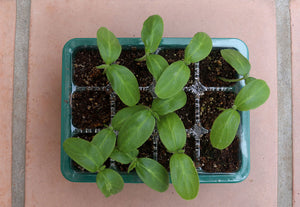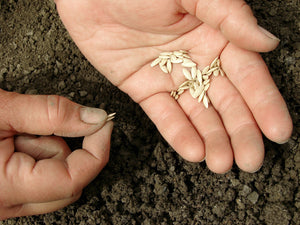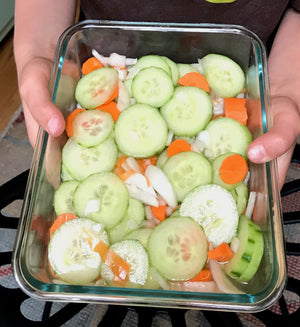Tips to help you start your cucumber plants from seed or seedling, cucumber plant care, and a tasty recipe for Quick Pickles.
DOWNLOAD PRINT VERSION

If You Start Seeds Indoors
What You Need
1. Seeds: It’s important to note the wide variety of cucumber fruits that vary in size, shape, and color. Cucumber plants are also often categorized as Bush or Vining.
Bush - varieties of cucumbers that stay more compact in size and do not require a trellis.
Vining - varieties of cucumbers that produce more fruit and require more space to sprawl outward or support with a trellis if growing upward.
Check your seed packet to determine your desired cucumber taste and goals, as well as what category works best within your growing space.
2. Small Pots: Each pot or planting cell should be at least 3 inches deep with good drainage. Some pots come with moisture domes that create a greenhouse effect and provide an optimal seed germination environment. (Once sprouts break soil surface, though, ditch the cover. Those tiny green leaves now need plenty of sun!)
3. Seed Starting Soil: Not only does this fluffy soil retain moisture better, but it lacks bulky material that makes it difficult for small sprouts to reach the surface.
4. A Warm Location: Ideal temperatures for seeds and seedlings are between 70-80 degrees but can go as low as 60 degrees. A greenhouse or heated location indoors does the trick to keeping your seeds warm. (Consistent moisture and warmth are key!)

If You Start Seeds Indoors
What To Do
1. Pour some seed starting soil into a large bowl or bucket.
2. Add water to the soil so that the mixture throughout becomes slightly damp.
3. Using your hands or a spoon, fill your pots or planting cells 3⁄4 of the way.
4. Use a pencil point to poke a small hole in the center of each pot (1⁄2” deep).
5. Insert one seed in each hole and gently cover the seed/s with soil.
6. Dampen seeds by misting with a spray bottle and place the pots in a warm location.
7. Once you see little sprouts, make sure they get plenty of sun to avoid them straining for UV rays and growing long, thin, and weak (sometimes referred to as “leggy”).

If You Sow Seeds Into the Ground
What You Need
1. Seeds: It’s important to note the wide variety of cucumber fruits that vary in size, shape, and color. Cucumber plants are also often categorized as Bush or Vining.
Bush - varieties of cucumbers that stay more compact in size and do not require a trellis.
Vining - varieties of cucumbers that produce more fruit and require more space to sprawl outward or support with a trellis if growing upward.
Check your seed packet to determine your desired cucumber taste and goals, as well as what category works best within your growing space.
2. The Right Location and Support: When the weather is warm (consistently above 60 degrees F), find a location for your cucumber plants. These tropical fruit-bearing plants will need 8 hours of full sun each day and plenty of room to grow. Keep in mind that vining cucumber plants also stretch out and sprawl. If space is an issue, plant seeds along a lattice or chain-link fence or use a trellis to support and train the vines to grow skyward. (Also – Keep in mind other plants in this area and Companion Plant with cucumber “bros.” See below.)
3. Fertile Well-Draining Soil: Cucumber plants thrive in nutrient-rich soil that also easily drains. By mixing in some compost or worm castings (make your own or purchase some from your favorite local plant nursery) before you plant, you are providing a fertile and loose soil environment for your cucumber plants to thrive!

Planting Cucumber Seedlings
1. When the weather is warm (consistently above 60 degrees F), find the right location for these tropical plants that need well-draining fertile soil and 8 hours of full sun each day.
2. If you transplant into the ground or a garden bed, determine if you plan to plant in rows or mounds. Keep in mind that vining cucumber varieties like to stretch out and sprawl and should be planted 12" apart. If space is an issue, you can plant a row along a lattice or chain-link fence or use a trellis (for rows or mounds) to support and train the vines to grow skyward.
3. Dig holes for each young plant that match the depth of the seedling pots. If you plan to move your seedling into a larger container, add some good soil first and then dig a hole that accommodates the appropriate depth.
4. Add water into the hole that will be the new seedling's home. This boost of hydration helps the plant avoid going into transplant "shock" in its new location.
5. Now, holding onto the plant's base, slowly tip the seedling sideways and pull out the plant while gently squeezing the seedling pot. Cucumber roots are very fragile and once the plant is removed, carefully hold the plant by supporting the root ball.
6. Gently place the cucumber plant into its new home and try to keep bottom leaves from getting buried. Continue adding soil to the hole and gently lift leaves above the soil surface. Then gently press down on the ground at the base to secure the plant in place.
7. Give the little seedling a fair amount of hydration, always watering where the plant's base meets the soil. (Try not to get the leaves wet as cucumber plants are prone to fungal diseases like powdery mildew. Drier leaves = a healthier plant!)
8. Monitor your seedling and water at the base of the plant as needed. Keep in mind that cucumbers like a lot of water. (1" every day, depending on the weather.)

Companion Planting
Companion planting is the method of growing multiple crops together. If done right, the crops can both enhance and protect one another.
Cucumber Plant “Bros” (awesome companion crops): Radishes, Beans, Carrots, Corn, Dill, Marigold Flowers, Sunflowers, and Nasturtium Flowers
Cucumber Plant “Foes” (crops to avoid): Potatoes, Melons, Sage, and Squash

Cucumber Plant Care
Support
Get creative with cucumber vining support for both disease protection and to maximize growing space. We like lattice fences, trellises, or stakes with wire strung between them. I also use twine to gently tie the vines to the structures to help steer growth and give the plants even more assistance. (Tip: position your support into the soil before planting your seedlings so that you won’t damage any of the roots, but rather the roots will grow around the structure/s.)
Hydration
Water these tropical plants daily (unless nature does it for you) and early in the morning. You also want to water at the base of the plant and not the leaves. These simple habits will help produce flavorful, juicy fruit and prevent fungal diseases like powdery mildew.
Airflow
Good airflow is SUPER important. It prevents fungal disease while also helping leaves dry out, which increases the amount of moisture and nutrients absorbed through plant roots. To increase airflow, remove any dead or decaying leaves and train the cucumber vines upward and away from one another.
Pest Control
One of the best ways to control pests is to create a protected environment. Companion planting with Dill attracts beneficial insects that will feast on some common cucumber plant pests, like aphids and cucumber beetles.
Give ‘em a Boost!
Compost is the best way to keep your cucumber plants happy. Every two weeks, place some compost or worm castings around the base of each to provide the needed nutrition for healthy leaves, vines, and fruit. (You can make your own compost and worm castings or purchase bagged products from your favorite local plant nursery.)

Quick Pickles
When you want them fresh and quick, make “Quick Pickles.” A variation of the real “dill,” but ready in a fraction of the time!
Ingredients
1 *Cucumber, thinly sliced
1 Sweet Onion, thinly sliced
1 Carrot, shavings or thinly sliced 3⁄4 Cup of Rice Vinegar
1 Tbsp of Sugar
3⁄4 tsp of Sea Salt
Directions
1. Combine the Cucumber, Onion, and Carrot slices into a large mixing bowl.
2. Mix the Vinegar, Sugar, and Salt in a small sized bowl.
3. Pour the liquid mixture over your fruit and veggies and stir them all together.
4. Enjoy your “pickled” vegetables right away or let them sit as long as you can wait!
You can can also experiment with:
*Any variety of cucumber will work when cut into slices.
Adding additional vegetables, such as cauliflower and radishes.


